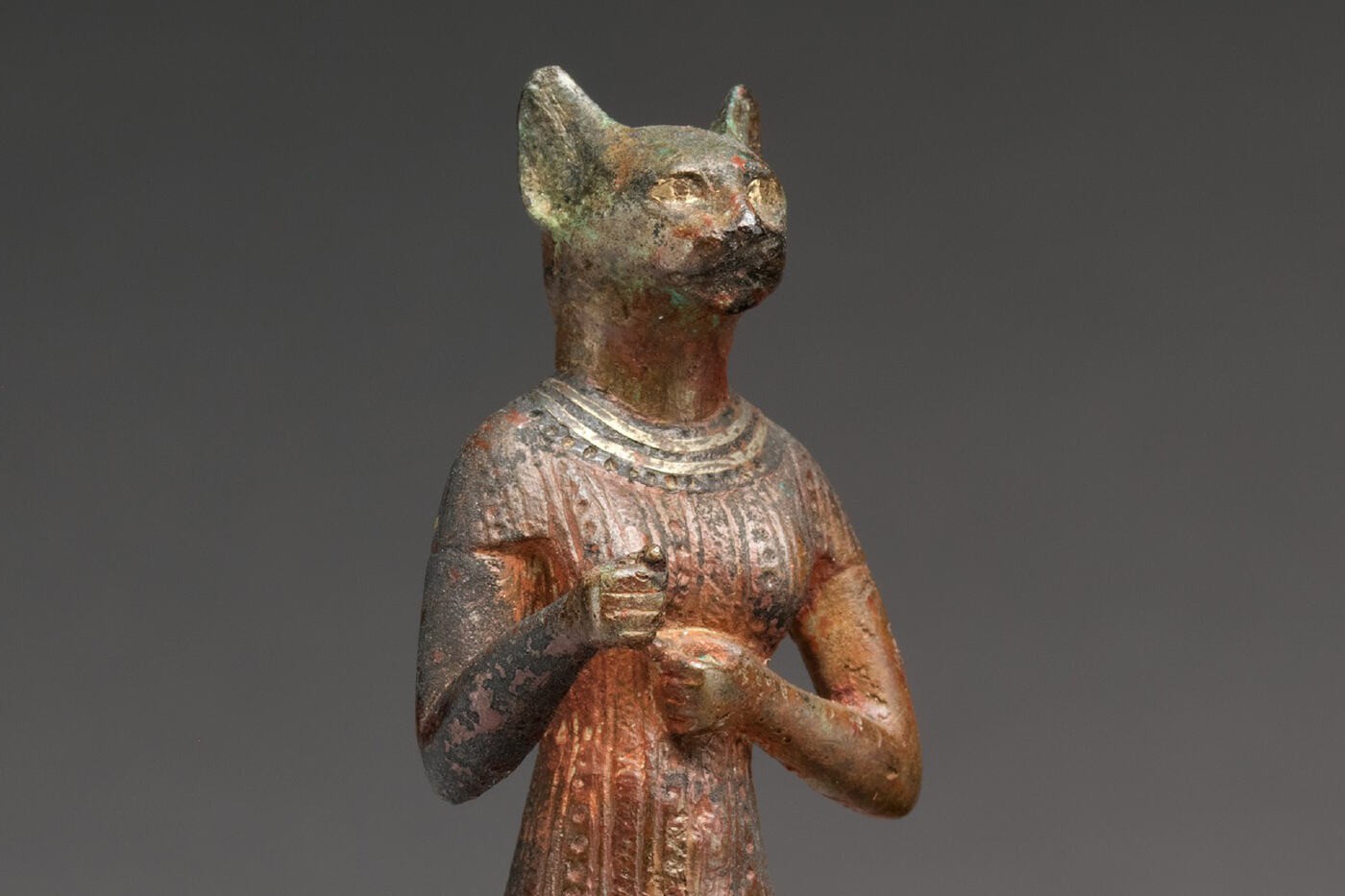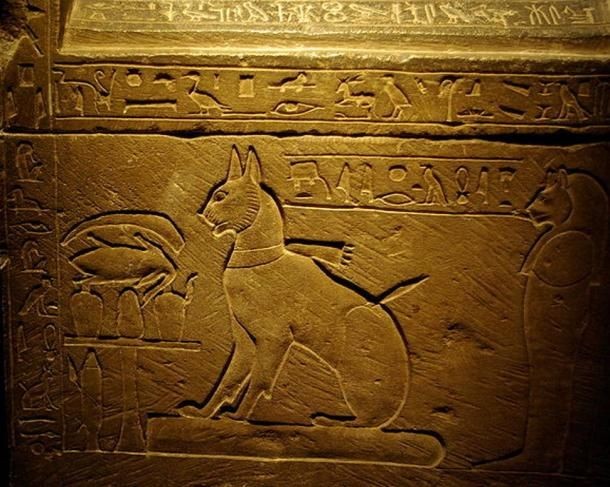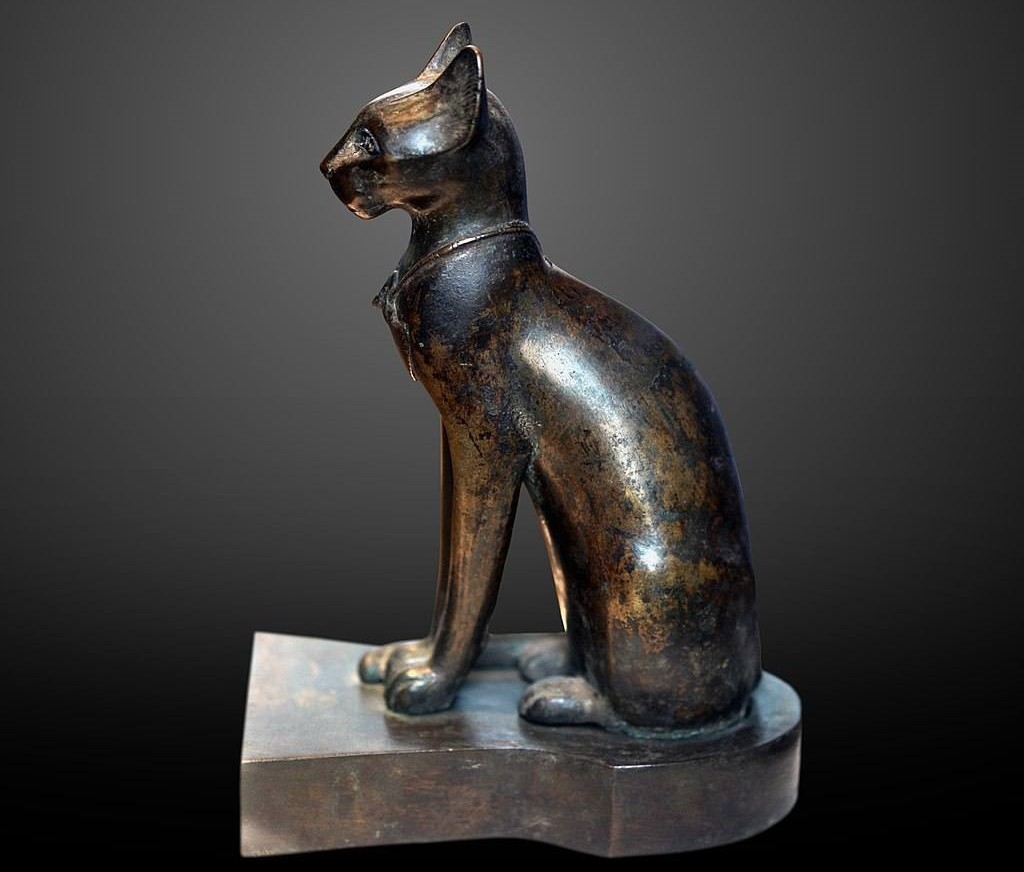The goddess of cats, Bastet, may have had her beginnings in the Libyan Desert. Because Bastet is affiliated with ISIS she becomes the Soul of Isis, yet as a goddess of music and dancing, Bastet is related with HATHOR The SISTRUM, which they bear as one of their characteristics, is their worship object.
Per-Bast (modern Bubastis), the Delta-based cult city of Bastet, is referred to in the Bible as Pibeseth (Ezekiel 30:17). The name Bastet, which translates as Woman of the Base-Jar or Special Jar, holds Perfume Associated with Her Festivals, is written with the bass jar (bs) and a loaf.

Bastet was referred to as "Goddess of the North" during the Old Kingdom, and in King UNAS's Pyramid Texts, she serves as the king's mother and nurse. Bastet took up the role of Lady of the East when SEKHMET, the lion goddess, was designated Lady of the West. Bastet is shown in early artwork as having a lion's head and being related to the goddess MUT, who also has a lion's head. She is claimed to be PTAH's wife and the mother of the lion-headed god MATHES.
Similar to Sekhmet, Bastet is capable of being both sweet and violent. Her connection to Sekhmet exposes Bastet's vindictive and violent nature. According to one interpretation of the narrative, Bastet is the sun god Re's daughter who, when asked to defend her father, transforms into a raging storm.
The most popular way to depict the feline goddess Bastet is as a cat-headed lady with a sistrum and an aegis. Bastet became a well-known home goddess because cats were common household pets in ancient Egypt. The eye of Re (Pat Remler photograph). She obeyed Re's commands as a responsible daughter and served as the vehicle for her father's retribution.
By the conclusion of the NEW KINGDOM (1550–1069 B.C), Bastet had established herself as a well-liked domestic goddess. As the goddess of the hearth and the protection of expectant mothers, Egyptian households welcomed her into their homes. She was referred to as the goddess of abundance and mistress of pleasure, and her festivals were well-known. As Bastet's fame spread, her religion gained notoriety for its opulent celebrations, some of which were known as the Procession of Bastet, Bastet Protects the Two Lands, Bastet Goes Forth from Per-Bast (her city), Bastet Appears before Re, and the Festival of Hathor and Bastet. These happy events included days of dancing, music, and fun all around Egypt.
When they travelled to the Festival of Bastet, the followers of the goddess are vividly described by the Greek historian Herodotus. Men and women ride together, and there are numerous people of both sexes in each boat, as the Egyptians journey to Bubastis, [the city]. During the entire voyage, some of the ladies shake holy rattles (sistrum, pl. sistra), and some of the men play pipes, while others sing and clap their hands. Some of the ladies yell and clap at the local women as they travel through towns, while others dance and cause a commotion. Every village on the Nile practises this. They start the holiday with significant sacrifices when they get to Bubastis, and more wine is drank during this celebration than at any other time of the year.

The worshippers marched up to the temple, chanting and playing tambourines and drums. Others danced through the streets while carrying sistra, or religious rattles. The opulent temple of Bastet, according to Herodotus, was situated in the middle of the city on a high area, making it easily visible from all directions. Around the shrine was a TEMENOS wall with numerous animals painted on it. A tree grove was erected in the interior courtyard.
Bastet was so well-known that the Greeks linked her to their own goddess Artemis. Ovid, a third-century Roman poet, claimed that the goddess Bastet could transform herself into a cat and makes reference to her in his work Metamorphoses. Bastet was most frequently shown as having a cat's head and a woman's body and donning a long, tight sheath-style garment with large decorative bands over the shoulders. In addition to her sistrum, the goddess is holding an AEGIS, a talisman that looks like a wide collar necklace with a cat's head, in her other hand. She is occasionally seen holding kittens at her feet, adding to the idea that she is associated with love and family.
A new term, pronounced meow, the sound a cat makes, was used in ancient Egypt to describe kittens. Children were referred to as now-Sheri, small cat, and it evolved into a name of love. Visitors came to Bastet's temple from all across Egypt to make tributes to the goddess. They left amulets, mummified cats, and bronze figurines since the cat was devoted to Bastet. In the location of Bastet's temple at Bubastis, underground crypts containing thousands of cat mummies have been found.
Find out our latest news, promotions, and professional tips. Know before you book your next Egypt tours
Egypt has many historical sites that you can visit and enjoy. Each tour is different and unique. If you go on a Nile cruise, you can visit Abu Simbel, Aswan, and Luxor in the South and enjoy the temples, tombs, and the treasures of the Nile. In the North, enjoy the Pyramids of Giza, The Egyptian Museum, Sakkara. Mosques, churches in Cairo, and many landmarks located in the city of Alexandria. On the East, Enjoy a beach tour for diving, snorkeling, and swimming in the Red sea. Every city has its charm, history, and flavor where you can do many tours and activities.
Your Egypt Tours is one of Egypt’s leading and most trusted travel agencies, known for its personalized service and expert care. As a top-rated company for Egypt tour packages, we ensure every Egypt trip is safe, seamless, and unforgettable, offering competitive prices, excellent customer service, and the highest standards of quality. With us, you’re always in good hands.
The average cost of a one-week trip in Egypt is around 1600 USD, including visits to tombs, temples, and a Nile cruise. Prices vary depending on the Egypt tours and the level of luxury you choose.
It’s not recommended to drink tap water in Egypt, as it’s highly chlorinated and may cause stomach issues for travelers. During your Egypt tours, it’s best to drink bottled water and use tap water only for washing or brushing your teeth.
The best time to enjoy Egypt tours is from September to March, when the weather is mild and pleasant. During these months, temperatures are ideal for sightseeing and Nile cruises. Summer (May to September) can be very hot, but it’s also a good time for budget travelers.
Egypt is generally hot and sunny most of the year, with winter falling between November and January, and summer peaking from June to August. Winters are mild, while summers can get very hot, especially in Luxor and Aswan. The pleasant weather from September to March makes it the best time to enjoy Egypt tours and explore the country's top attractions comfortably.
Yes, Egypt is a very safe country to visit, with a low crime rate and strong security measures in all tourist areas. The government ensures that accommodations and attractions remain clean and well-monitored for travelers’ comfort. When you book Egypt tours, you’ll find professional guides and organized arrangements that make your trip worry-free and enjoyable.
Egypt offers adventures for every traveler. Explore the majestic Pyramids of Giza, sail along the Nile on a Luxury cruise between Luxor and Aswan, and discover ancient temples and tombs that tell the story of the Pharaohs. Dive or snorkel in the Red Sea at Hurghada and Sharm El Sheikh, or enjoy a relaxing beach escape. Book one of our Egypt tours to experience the perfect mix of history, culture in one unforgettable journey.
Yes, you can, summer is still a great time to explore Egypt! While temperatures can rise to around 45°C, seaside resorts like Hurghada, Sharm El Sheikh, and Marsa Alam offer refreshing escapes with diving and snorkeling opportunities. Sightseeing in the early morning or evening helps you avoid the midday heat. Summer also brings great deals on hotels and services, making it ideal for travelers on a budget. Whether you’re seeking relaxation or adventure, Egypt tours during summer can still be an enjoyable and memorable experience.
Egypt has a modest dress code, especially for women, since it’s a Muslim country. Light, comfortable clothing is fine, but avoid short shorts or skirts. When visiting religious sites, cover your shoulders and knees. During Egypt tours, you can dress casually and comfortably; formal wear is optional unless you want to make your Nile cruise dinner extra special.
You can easily obtain a visa upon arrival at Cairo Airport, the process is simple for USA, UK, Canadian, Australian, and European citizens. The visa costs $25 USD and can be purchased at the visa office before immigration. You can also apply for an E-Visa through the official portal: www.visa2egypt.gov.eg. During your Egypt tours, our team can assist you with all visa-related inquiries to make your arrival smooth and stress-free.
Your Egypt Tours travel agency recommends two weeks so that you can enjoy the temples and tombs of Luxor and Aswan, explore the sights of Cairo, and relax in the Red Sea islands and nature reserves.
The best Egypt Nile River cruise depends on your preferences, budget, and how many nights you wish to spend on board. For a truly unforgettable experience, we recommend a 5-star luxury Nile cruise that offers exceptional comfort and service. If you prefer a more private and intimate journey, choose a Dahabiya Nile cruise, ideal for small groups of around 15 people. For adventurous travelers, the traditional Felucca boats provide a simple and authentic way to sail the Nile during your Egypt tours, though they offer fewer amenities.
The best time to visit Egypt is generally from October to April where it is suitable for outdoor activities and sightseeing.
Egypt travel usually have guided tours to archaeological sites, museums, and historical landmarks. Also have optional activities may include hot air balloon rides over Luxor, snorkeling in the Red Sea, or desert safaris.
